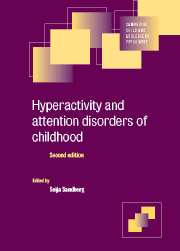Book contents
- Frontmatter
- Contents
- List of contributors
- Preface
- 1 Historical Development
- 2 Epidemiological aspects: what have we learned over the last decade?
- 3 Cross–cultural/ ethnic aspects of childhood hyperactivity
- 4 4 Sex differences and their significance
- 5 Classification issues
- 6 The role of attention
- 7 Cognitive aspects and learning
- 8 Developmental perspectives
- 9 Behavioural and molecular genetic studies
- 10 Biological underpinnings of ADHD
- 11 Psychosocial contributions
- 12 Institutional care as a risk factor for inattention/overactivity
- 13 Treatments: The case of the MTA study
- 14 Attention feficit hyperactivity disorder in adults
- Index
9 - Behavioural and molecular genetic studies
Published online by Cambridge University Press: 28 August 2009
- Frontmatter
- Contents
- List of contributors
- Preface
- 1 Historical Development
- 2 Epidemiological aspects: what have we learned over the last decade?
- 3 Cross–cultural/ ethnic aspects of childhood hyperactivity
- 4 4 Sex differences and their significance
- 5 Classification issues
- 6 The role of attention
- 7 Cognitive aspects and learning
- 8 Developmental perspectives
- 9 Behavioural and molecular genetic studies
- 10 Biological underpinnings of ADHD
- 11 Psychosocial contributions
- 12 Institutional care as a risk factor for inattention/overactivity
- 13 Treatments: The case of the MTA study
- 14 Attention feficit hyperactivity disorder in adults
- Index
Summary
Considerable developments have occurred in the research on and conceptualization of attention deficit hyperactivity disorder (ADHD) over the past 15 years. The classification of the disorder has shifted repeatedly in both the USA and Europe, manifested by major changes to both the International Classification of Disease (ICD: World Health Organization, 1992) and Diagnostic and Statistical Manual of Mental Disorders (American Psychatric Association, 1994) classifications. A number of studies (Weiss and Hechtman, 1986; Lilienfield and Waldman, 1990; Manuzza et al., 1993) have increased our understanding of the long-term course and outcome of ADHD, suggesting that ADHD children have lower educational attainment, lower income and underemployment as well as higher rates of school drop-out, adult criminality and substance abuse than children without the disorder. Research on the overlap of ADHD with other conditions (Lilienfeld and Waldman, 1990; Biederman et al., 1991) has shed light on the extensive and varied nature of the psychopathology experienced by many ADHD children, including rates of oppositional defiant disorder (ODD) and conduct disorder (CD) and anxiety and depressive disorders that are much higher than population base rates. Perhaps the most dramatic increase in the research literature over the last 15 years has been the increase in our knowledge of the aetiology of ADHD. In this chapter we review research that examines the aetiology of ADHD by investigating its underlying genetic and environmental influences.
- Type
- Chapter
- Information
- Hyperactivity and Attention Disorders of Childhood , pp. 290 - 335Publisher: Cambridge University PressPrint publication year: 2002
- 1
- Cited by

